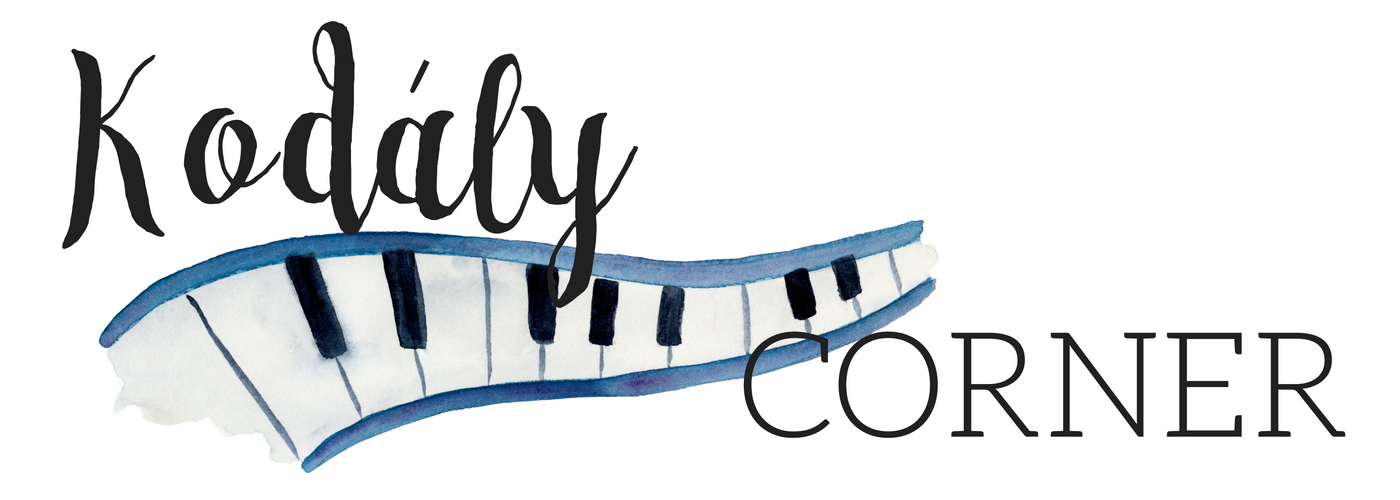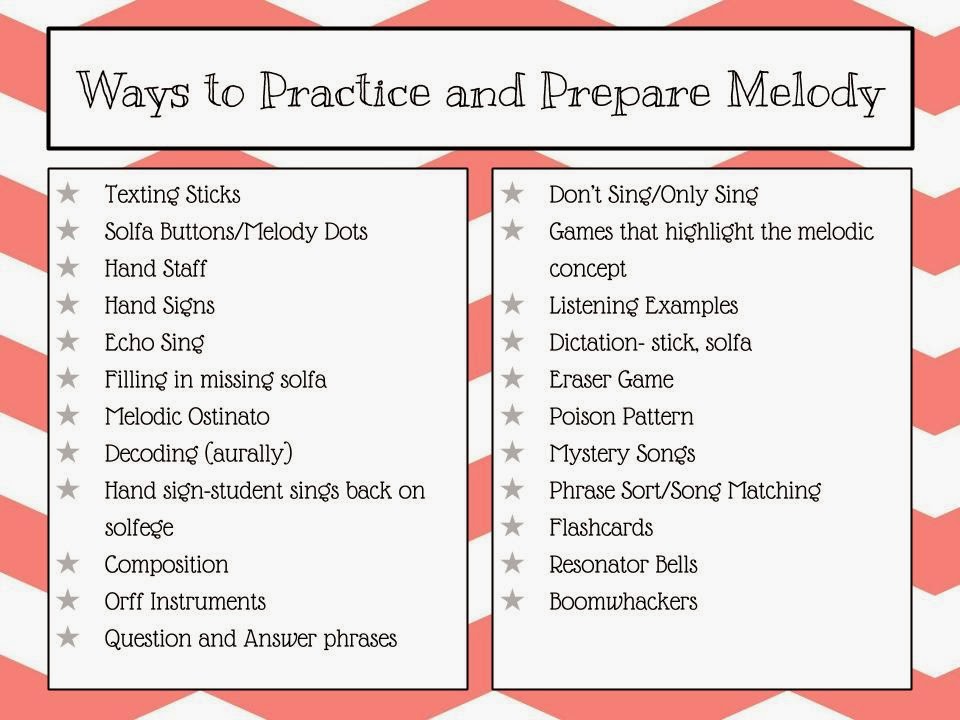We are in the final stretch!! I hope that you have had a moment to soak up some of the joy this season brings a midst all the insanity and chaos!
Today, I am going to follow up my last post, "Ways to Practice and Prepare Rhythms" with the Melody Edition! Just like last time, this is not a comprehensive list. However, I keep this up as a reminder of the many, many ways I can help my students master melodic concepts! A quick FYI... These ideas are more related to helping your students learn to sing pitches and pitch relationships correctly, and not to staff work. Maybe that will be my next post. :)
1. Texting Sticks
I first saw these used at the Colorado Music Educator's Conference. At first, I was skeptical. However, I find that my 2nd and 3rd graders really enjoy using them, and they are a great reinforcement of note relationships. The only draw back is that they have the whole scale on them...
I simply sing a melody on solfege or a neutral syllable and then the students sing and "text" it back to me by playing the notes on their stick with their thumb.
2. Solfa Buttons/Melody Dots
You can use these a lot of ways- echo singing, decoding, point to a pattern and then have your students sing it back. I especially like using this visual because you can remove/add notes as you introduce them. I find that it is a really great way to reinforce steps/skips and how notes relate to each other. Sometimes, I even have my students come up and put the buttons in the right order, leaving spaces where there should be spaces. If you don't have a set of Solfege Buttons, you can find my set on TpT by clicking here
I will often have students use a hand staff to "write" melodies. This is especially effective with limited pitch sets (so-mi-la), and it is a great visual and physical way to practice staff notation!
4. Hand Signs
Using the Curwin Hand Signs is a great way to practice and prepare melodies. Some of the many ways I use them are:
- Sing my Sign- I will sign a pattern, but only sing the first note. Then they sing it back to me.
- Echo singing with hand signs
- Sign my Song- I will play a short melodic pattern on the xylophone or piano and they sign it back to me
This one is pretty obvious, but a very important part of developing correct intonation and pitch relationships for your singers!
5. Fill in the Missing Solfege
I will notate a song in stick or staff notation and then have my students come up and write the solfege below the notes. You can have them fill in all the solfege or leave just a few blank.
6. Melodic Ostinato
I love adding melodic ostinatos to reinforce the concept we are working on. For example, when my 3rd graders learned low sol, we used the song "Morning Has Come" and added an ostinato of "s, s, s, d" (three quarter notes followed by a dotted half). This is great practice of singing low sol and part work, plus it excites the kids to add complexity to the music!
7. Aural Decoding
I sing a pattern on a neutral syllable and they sing it back in solfege.
8. Composition
This could be a whole post, so I am not going to dive into it too much. However, composing is one of the best ways for kids to practice melodies (in my opinion). You can compose with manipulatives, using stick notation, on the staff... You can compose as small groups, a whole class, individual composers... The options are endless!
9. Orff Instruments
Using Orff to reinforce melodic concepts is a great way to add variety to the singing-focused Kodaly lesson. When I teach ostinati or patterns on xylophones and other Orff instruments, I teach them completely through solfege. I have a big xylophone that I laminated so we can write the solfege on the bars along with the absolute pitch name, and that allows me to have a moveable do. It's also great, because you can take the bars off to represent the pitch relationships!
Here are just a few ways you can use Orff to reinforce melodic concepts...
- Echo playing- you sing a pattern on solfege and they play it back on Orff
- Ostinati- add an ostinato to a folksong you are using to reinforce the note you are working on.
- Song Extraction- my kids love to extract "l s m s" and "m m r d" from 'Liza Jane and play it on the Orff instruments.
- Composition- Kids love to create melodies on the Orff instruments!
10. Question and Answer Phrases
I sing a "question" in solfege and my student/students respond with an "answer." You can have a set answer that is a four beat melody everyone knows, have students come up with their own answers, or ask students to include some of your question in their answer. This is definitely challenging, but it can also be a lot of fun!
11. Don't Sing/Only Sing
My kids love this one. When we are practicing a note, I will tell them "don't sing" or "only sing" the note we are practicing. For example, if we are are working on "la" I would have my students only sing the "las" in Bounce High, Bounce Low and I would sing everything else. You can also do the reverse and have them sing everything else while you sing the new pitch to help them hear the correct intonation. A final step is to split the class into two groups and have the groups sing each part. This works really well with older students, too!
12. Games that highlight the melodic concept
The first example of this that comes to mind is "The Farmer's Dairy Key." The way I play this game, the gates lift up their arms at the high do (which is the concept I teach with this song). So, that is a great physical and visual reinforcement of that pitch.
13. Listening Examples
I sometimes forget that listening is a great way to practice melody. Having students listen for melodic patterns, ostinati, etc. are GREAT reinforcements of new melodic concepts. I've mentioned it before, but if you haven't checked out "From Folksongs to Masterworks," I highly recommend it!
14. Dictation
Dictation having students simply writing down what they hear, and it can be used at any phase of a melodic concept. If you are preparing, you can have the students write the solfege underneath the stick notation. If you are practicing, you can have them notate the melody on the staff. I like to mix-up my dictation by having them dictate from my singing, the piano, a xylophone, my recorder, etc. As your students get older, you can make the melodies longer and more challenging to keep them engaged!
15. Eraser Game.
Write a melody (in either stick or staff notation) on the board. Have the students sing it and then "accidentally" erase it piece by piece until they have memorized the whole song. You can also have them rewrite the melody when you are done for extra practice!
16. Poison Pattern
This is the same as the rhythm version, except with sung melodies. There are TONS of poison games on Teachers Pay Teachers that you can check out if you are looking for a specific concept to play with!
17. Mystery Songs
Write a song in either stick or staff notation and have students sing it on solfege. Then have them try to identify the folk song. I often will give 3 or 4 choices to help students narrow it down!
18. Phrase Sort/Song Matching
Cut up a song into phrases or short chunks and have your students put it back together. You can also show several short phrases and ask students to identify which song they came from (I provide a song bank for my students to use). It's also fun to include an extra or a mis-fit phrase to trick your students!
19. Flashcards
Flashcards are pretty obvious, but there are SO many things you can do with flashcards. One game my students love is "Flashcard Elimination." I put 5 or 6 one measure melodies on the floor and then play a song for them to walk around to. When the music stops they stop at a flashcard. I then sing or play a melody from one of the flashcards. If they are at that card, they are eliminated and have to sit down. The game continues until their is one child remaining. It usually goes pretty quick (because you have a lot of control over which card you sing) and the kids are always asking to play again! This is a great way to reinforce reading and connecting sight and sound.
20. Resonator Bells/Boomwhackers
While I don't love the sound of Boomwhackers, I really love that they allow you to practice how pitches are related to each other. Sometimes we will set up "Solfa Street" in my class with live people and instruments (like resonator bells or boomwhackers). Kids go for a walk down the street and "ring the doorbell" at each house. When they do, the child at that pitch plays their instrument. It's a fun way to get kids moving, listening and learning!
I feel like I have only scratched the surface, but hopefully you have a new idea or two to take with you! Please comment with any brilliant ideas you have used in your classroom! Wishing you all a happy, healthy, and safe holiday season!!















.jpg)







